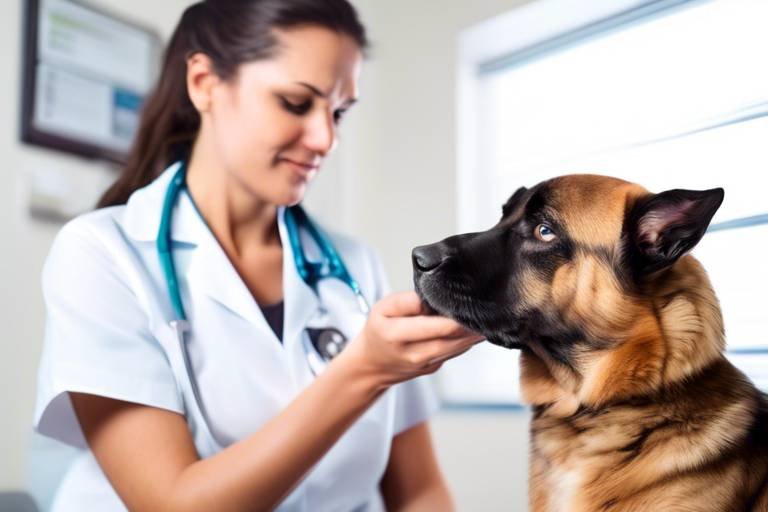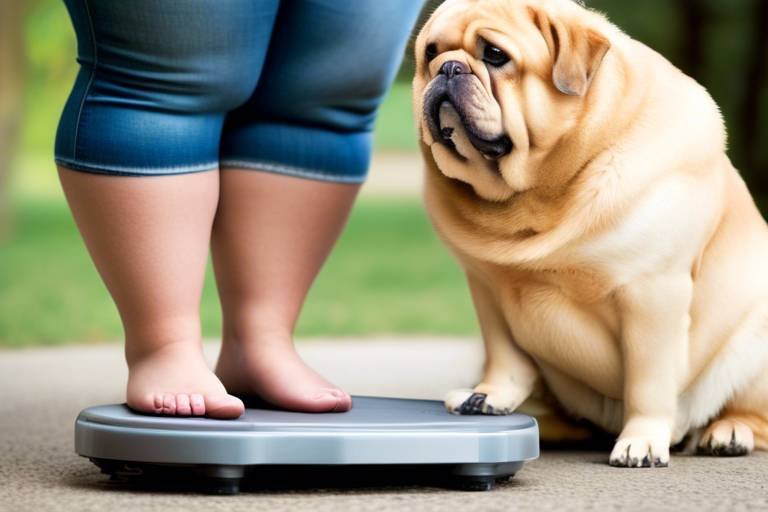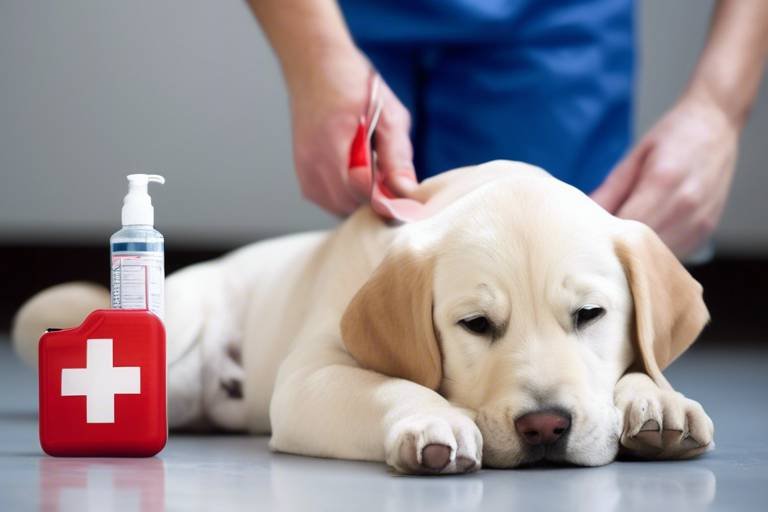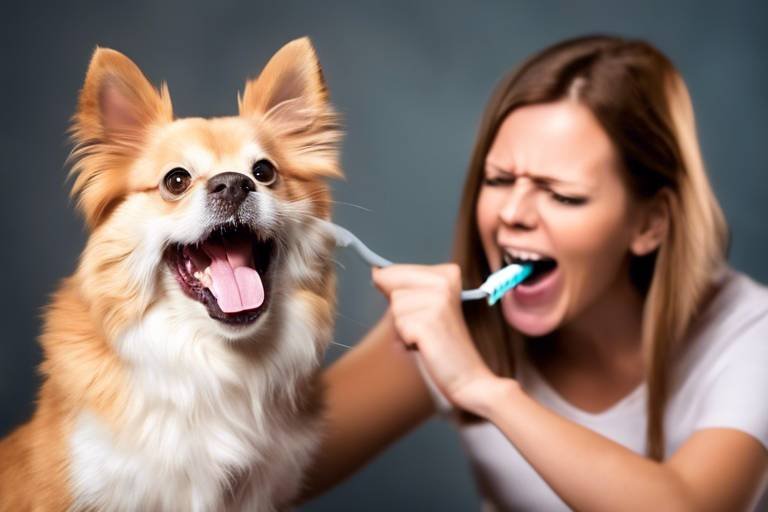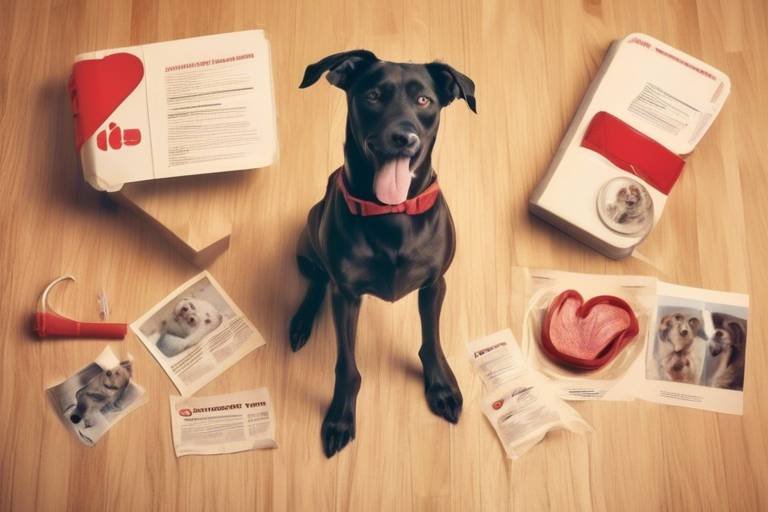How to Keep Your Pet Calm During Vet Visits
Taking your furry friend to the vet can often feel like a daunting task. Just the thought of it can send shivers down both your spine and your pet's! But fear not, because with a little preparation and some clever strategies, you can transform this potentially stressful experience into a walk in the park. It's all about understanding your pet’s needs and creating a calm environment that makes them feel safe and secure. In this article, we’ll explore effective strategies and tips that will not only help your pet remain calm and relaxed during veterinary visits but also make the experience more enjoyable for you as an owner. After all, a happy pet means a happy owner, right?
Recognizing the signs of anxiety in pets is crucial for a successful vet visit. Just like us, pets can experience anxiety, and it often manifests in ways we might not immediately recognize. Common behaviors that indicate stress include excessive barking, hiding, panting, or even destructive behaviors. Imagine your pet feeling overwhelmed, much like a child in a crowded room—it's essential to understand what triggers their anxiety. By being aware of these signs, you can prepare yourself and your pet for the visit ahead. Remember, the more you understand your pet's feelings, the better equipped you'll be to help them navigate through their fears.
Preparation can significantly reduce anxiety for both you and your pet. Think of it as setting the stage for a successful performance. Before the appointment, one of the best things you can do is familiarize your pet with their carrier and the vet's office environment. This means allowing your pet to explore the carrier at home, turning it into a cozy den rather than a scary box. You might even want to take a trip to the vet's office just to hang out in the waiting area, so your pet can get used to the sights and sounds without the pressure of an actual appointment.
The right carrier can make a world of difference when it comes to your pet's comfort and security during transport. There are various types of carriers available, from hard-sided to soft-sided options. When selecting a carrier, consider your pet's size, personality, and comfort preferences. A well-ventilated carrier that allows your pet to stand up and turn around comfortably is ideal. It's like choosing the perfect cozy blanket for a chilly night—your pet deserves nothing less!
Training your pet to feel comfortable in the carrier is essential for a stress-free vet visit. Start by leaving the carrier open in a familiar space at home, encouraging your pet to explore it at their own pace. You can make it more inviting by placing their favorite blanket or some treats inside. Over time, your pet will begin to associate the carrier with positive experiences, much like how we feel about our favorite chair after a long day. Remember, patience is key!
Getting your pet used to car rides can alleviate stress on the day of the visit. Start with short, enjoyable trips to fun places, like a park or a friend’s house. This way, your pet can build positive associations with being in the car. If your pet tends to get anxious, consider using a pet seatbelt or a travel crate for safety. Think of it as buckling up for a fun adventure—your pet will feel secure and ready to explore!
On the day of the visit, specific calming techniques can help soothe your pet's nerves. Playing soothing music in the car can create a relaxing atmosphere, while pheromone sprays can mimic calming scents that help reduce anxiety. You might also want to bring along interactive toys to keep your pet occupied during the wait. It's like packing a little bag of comfort for your furry friend, ensuring they have everything they need to feel at ease.
How pets are handled during the visit can significantly impact their stress levels. When you arrive at the vet's office, try to keep your pet calm while waiting. Speak softly to them and offer gentle pets to reassure them. If possible, choose a quiet time for your appointment to minimize the hustle and bustle around you. A calm environment is key to helping your pet feel secure.
Using treats and praise can create a positive association with the vet. When your pet displays calm behavior, reward them with a treat or a gentle word of encouragement. This technique not only reinforces good behavior but also helps your pet understand that the vet visit can be a positive experience. It's like giving them a little high-five for being brave!
Timing your visit can also affect your pet's mood. Consider scheduling appointments during quieter times at the vet’s office, such as mid-mornings or early afternoons. This strategy minimizes the chances of encountering other anxious pets and creates a more serene environment for your furry friend. Think of it as picking the right moment to enjoy a beautiful sunset—timing is everything!
- What should I do if my pet is overly anxious? If your pet shows extreme anxiety, consult your vet for advice on calming medications or techniques.
- How can I make the carrier more inviting? Place familiar items, like your pet’s favorite blanket or toys, inside the carrier to create a cozy environment.
- Is it okay to bring my pet's favorite toy to the vet? Absolutely! Familiar items can provide comfort and help ease anxiety.
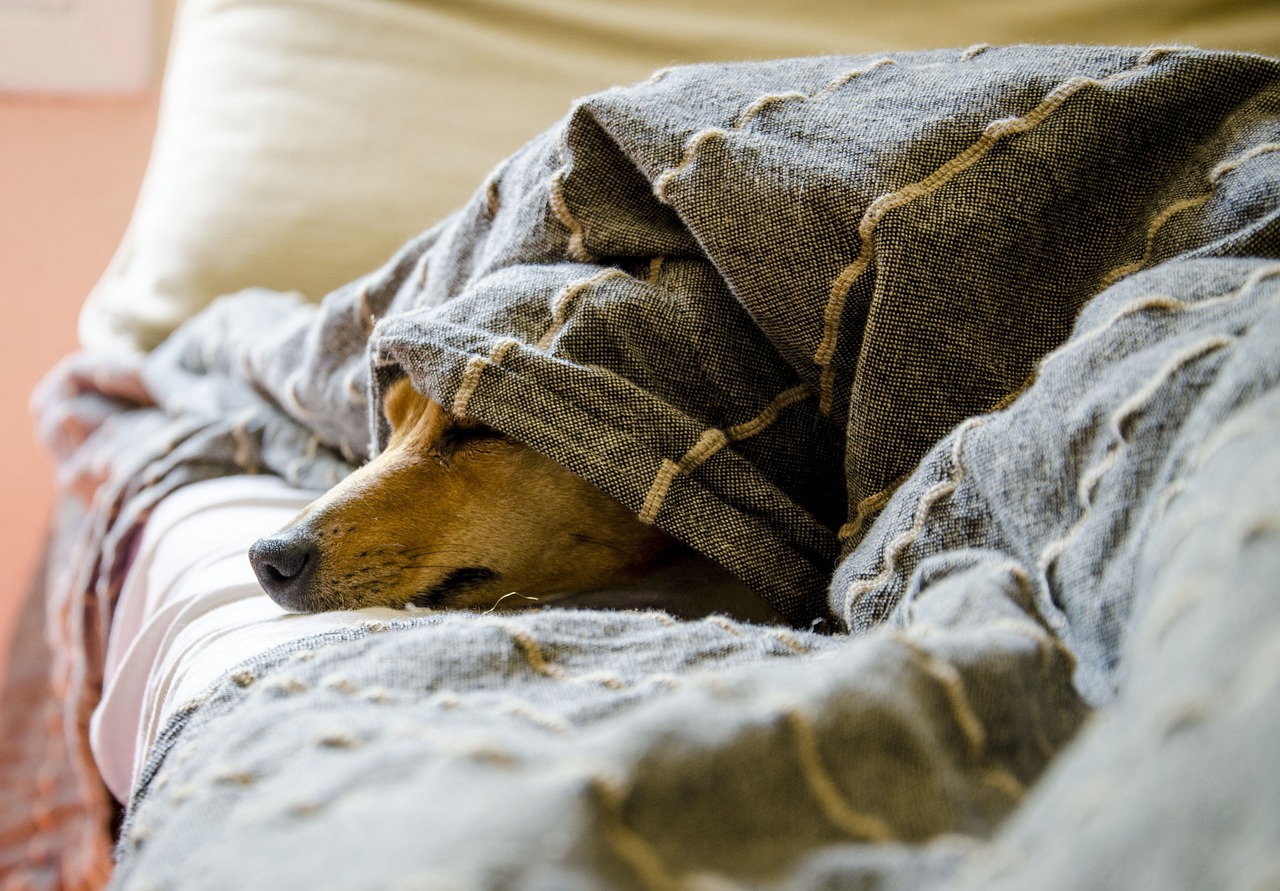
Understanding Pet Anxiety
When it comes to our furry companions, understanding their anxiety is the first step in ensuring a calm and stress-free visit to the vet. Just like humans, pets can experience anxiety, and recognizing the signs can help you prepare for their appointment. Common behaviors that indicate stress in pets include excessive barking, hiding, or even trembling. Imagine your pet as a little sponge, soaking up their environment; if that environment feels threatening, they may react in ways that surprise us.
Pets may show their anxiety through a range of behaviors, such as:
- Hiding: Many pets will seek out a safe space, such as under a bed or in a closet, when they feel anxious.
- Excessive vocalization: Some pets may bark or meow more than usual, expressing their discomfort.
- Destructive behavior: Chewing or scratching at furniture can be a sign of stress.
- Pacing or restlessness: An anxious pet may have difficulty settling down, constantly moving around.
- Withdrawal: Some pets may become less interactive, refusing to engage with their owners or toys.
Understanding these signs is crucial because it allows you to tailor your approach to your pet's needs. For instance, if your dog tends to hide, you might want to create a cozy, secure space at home where they can feel safe before the visit. Think of it as preparing a sanctuary for them—a little oasis in a world that feels overwhelming.
Additionally, it's important to note that different pets may react differently to the same situation. A cat, for instance, might exhibit anxiety through hiding, while a dog might bark or whine. By observing your pet's unique behaviors, you can better anticipate their reactions and take steps to mitigate their anxiety. Remember, pets are incredibly perceptive; they can sense our emotions and may mirror our feelings. If you’re anxious about the vet visit, your pet may pick up on that energy, making the situation even more stressful.
In summary, recognizing the signs of pet anxiety is not just about identifying a problem—it's about building a foundation of understanding and empathy for your furry friend. By being aware of their behaviors and emotions, you can take proactive steps to make their vet visits as smooth and calm as possible. After all, a little preparation goes a long way in ensuring that your pet feels safe and secure, turning what could be a stressful experience into a manageable one.

Preparing for the Visit
When it comes to ensuring that your furry friend stays calm during a vet visit, preparation is key. Just like you wouldn't walk into a big meeting without a little prep work, your pet deserves the same consideration. A well-planned approach can significantly reduce anxiety and set the stage for a smoother experience. So, what can you do to make the vet visit less stressful for your pet? Let's dive into some essential steps that can help.
First off, one of the most important things you can do is to familiarize your pet with their carrier. This is their transport to the vet, and if they associate it with fear or discomfort, you're already starting off on the wrong foot. Start by introducing the carrier at home. Leave it open in a cozy spot and encourage your pet to explore it on their own terms. Toss in a few treats or their favorite toys to create a positive association. You want them to think, “Hey, this is my safe space!”
Another crucial aspect of preparation is to acclimate your pet to the vet's office environment. If possible, take a few trips to the vet’s office just for a visit, without an appointment. Let your pet sniff around and get used to the sights and sounds. This exposure can help demystify the experience, making it less daunting when it’s time for an actual check-up. Plus, it gives them a chance to meet the staff and maybe even score a few extra treats!
The right carrier can make a world of difference in your pet's comfort level. There are various types available—hard-sided, soft-sided, and even backpack-style carriers. Each has its pros and cons, so consider your pet’s size, temperament, and preferences when making a choice. For instance, if your pet is a bit skittish, a soft-sided carrier might feel less intimidating. On the other hand, if you have a larger pet, a hard-sided carrier might provide the structure they need to feel secure.
Once you've selected the right carrier, it’s time to train your pet to feel comfortable inside it. Start by leaving the carrier open in a familiar area of your home. Encourage your pet to explore it at their own pace. You can use treats, toys, or even their favorite blanket to entice them. Gradually, you can begin closing the carrier door for short periods while they're inside, rewarding them with praise and treats when they remain calm. This positive reinforcement will help them associate the carrier with good experiences.
Now, let’s talk about the car ride—this can be another source of anxiety for pets. To help your furry friend get used to the car, start with short trips around the block. Make these outings fun! Bring along their favorite toy or a tasty treat to create a positive experience. Gradually increase the length of the trips, always rewarding calm behavior. This way, when the big day arrives, your pet will be more accustomed to the car environment, making the journey to the vet less stressful.
By taking these preparatory steps, you're not just reducing anxiety for your pet; you're also setting the stage for a more successful vet visit. Remember, a calm pet equals a calm pet owner, and that’s a win-win situation!
Q: How can I tell if my pet is anxious about going to the vet?
A: Look for signs like hiding, excessive barking or meowing, panting, or attempts to escape the carrier. These behaviors often indicate stress or anxiety.
Q: What if my pet refuses to go into the carrier?
A: Patience is key! Continue to encourage them with treats and positive reinforcement. You may also want to consider using a different type of carrier that feels more inviting to them.
Q: Should I feed my pet before the vet visit?
A: It depends on your pet's individual needs and the type of visit. Some pets may benefit from a light meal, while others might feel better fasting to avoid motion sickness.
Choosing the Right Carrier
When it comes to ensuring your furry friend feels secure during vet visits, selecting the right carrier is paramount. Think of the carrier as a cozy little sanctuary for your pet, a place where they can feel safe and snug amidst the hustle and bustle of the vet's office. But how do you choose the best one? First, consider the size of your pet. A carrier should be spacious enough for your pet to stand up, turn around, and lie down comfortably. If your pet feels cramped, it can lead to increased anxiety.
Next, think about the type of carrier that suits your pet's personality. There are primarily two types: hard-sided and soft-sided carriers. Hard-sided carriers are excellent for larger pets or those who might be a bit more rambunctious. They provide a sturdy environment that can withstand a bit of rough handling. On the other hand, soft-sided carriers are lightweight and often easier to store, making them ideal for smaller pets or those who enjoy snuggling into a cushy space.
Another essential aspect to consider is the entrance style of the carrier. Some pets prefer a top-loading carrier, which can make it easier to place them inside without the stress of coaxing them through a narrow door. Meanwhile, a front-loading carrier might work better for pets that are more accustomed to being handled. Remember: the goal is to make the experience as stress-free as possible.
To help you visualize the differences, here’s a quick comparison table:
| Carrier Type | Best For | Pros | Cons |
|---|---|---|---|
| Hard-Sided | Larger or more active pets | Sturdy, secure | Heavier, less portable |
| Soft-Sided | Smaller or calmer pets | Lightweight, easy to store | Less durable, may not hold up to rough handling |
Finally, don't forget to check the ventilation and safety features of the carrier. Adequate ventilation is crucial; it ensures your pet can breathe easily and stay comfortable during transport. Look for carriers with mesh panels or vents that allow for airflow. Additionally, ensure the carrier has secure latches and no sharp edges that could harm your pet. After all, a carrier should be a safe haven, not a source of stress.
By taking the time to choose the right carrier, you're setting the stage for a more relaxed and positive vet visit. Remember, this small investment in comfort can lead to a significant reduction in anxiety for both you and your beloved pet!
Carrier Training Techniques
Training your pet to feel comfortable in their carrier is a crucial step in ensuring a stress-free visit to the vet. Think of the carrier as a cozy den, a safe space where your furry friend can feel secure. The goal is to create a positive association with the carrier, making it a place they want to be rather than a dreaded box. Start by introducing the carrier in a relaxed environment at home. Place it in a familiar area and leave the door open, allowing your pet to explore it at their own pace. You can even entice them with their favorite toys or treats, making the carrier feel like a fun adventure rather than a confinement.
Once your pet shows interest in the carrier, you can begin the process of getting them accustomed to spending time inside. Gradually increase the duration they spend in the carrier, rewarding them with treats and praise for calm behavior. This positive reinforcement is key; it’s like giving them a little pat on the back every time they take a step in the right direction. For example, if your pet enters the carrier on their own, shower them with affection and perhaps a tasty treat. This creates a mental link between the carrier and something enjoyable.
Another effective technique is to practice short trips with the carrier. Start with just a few minutes in the car, perhaps driving around the block, and then return home. This helps your pet associate the carrier with positive experiences outside of vet visits. Remember, the goal is to gradually desensitize them to the carrier and the car environment. If your pet seems anxious during these practice runs, don’t rush the process; instead, take a step back and continue to build their comfort level.
Additionally, you might want to consider using calming aids such as pheromone sprays designed to reduce anxiety. Spraying the inside of the carrier with a calming scent can help soothe your pet. Just like a comforting blanket, these sprays can create a more inviting atmosphere. Always ensure that your pet has plenty of opportunities to explore the carrier freely and make it a part of their everyday environment. The more familiar they become with it, the less anxious they will feel when it’s time to visit the vet.
In summary, training your pet to love their carrier is all about patience and positivity. By making the carrier a safe and enjoyable space, you’ll not only ease their anxiety during vet visits but also create a more pleasant experience for both of you. Remember, every pet is unique, so tailor your approach to what works best for your furry friend. With time and effort, you’ll see a transformation from a hesitant pet to one that happily hops into their carrier, ready for the next adventure!
Q: How long should I spend training my pet to use the carrier?
A: It varies by pet, but consistent short sessions over several days or weeks usually yield the best results. Aim for 10-15 minutes a day.
Q: What if my pet refuses to enter the carrier?
A: Try placing their favorite toys or treats inside to entice them. Never force them; this can create a negative association.
Q: Are there specific types of carriers that are better for training?
A: Soft-sided carriers are often more inviting for pets, but ensure the carrier is sturdy and well-ventilated. Choose one that suits your pet's size and comfort needs.
Q: Can I use calming products while training my pet?
A: Yes! Calming sprays or diffusers can be helpful. Just make sure to test them on a small area first to ensure your pet doesn’t have any adverse reactions.
Acclimating to the Car
Getting your pet accustomed to car rides can be a game changer when it comes to reducing anxiety during vet visits. Just like humans, pets can feel uneasy in unfamiliar environments, and the car can be a source of stress for many furry friends. So, how can you make those trips more enjoyable for your pet? It's all about gradual exposure and positive experiences.
Start by introducing your pet to the car in a calm and relaxed setting. Open the car doors and let them explore the interior at their own pace. This can help them associate the car with a safe space rather than a vehicle that leads to stressful situations. To make this experience even more enjoyable, consider bringing along some of their favorite toys or blankets. The familiar scents can provide comfort and reassurance.
Next, take short trips around the block or to a nearby park. This not only acclimates your pet to the motion of the car but also helps them understand that not all car rides lead to the vet. Use these short outings to reward your pet with treats and praise, reinforcing the idea that car rides can be fun! It’s important to keep these initial trips brief, so they don’t feel overwhelmed.
As your pet becomes more comfortable, gradually increase the length of the car rides. You might also want to consider the following tips to further ease their anxiety:
- Secure Your Pet: Use a pet seatbelt or a carrier to keep them safe and secure during the ride.
- Calm Environment: Play soothing music or use calming pheromone sprays to create a relaxed atmosphere in the car.
- Frequent Breaks: For longer trips, make sure to stop frequently to let your pet stretch their legs and relieve themselves.
Remember, patience is key! Each pet is unique, and it may take some time for them to feel completely at ease in the car. By taking gradual steps and creating positive associations, you can help your furry friend enjoy car rides, making those trips to the vet much less stressful for both of you.
Q: How long should I spend acclimating my pet to the car?
A: It varies by pet, but start with a few minutes of exploration and short rides, gradually increasing the duration as they become more comfortable.
Q: What if my pet gets car sick?
A: If your pet shows signs of motion sickness, consult your veterinarian for advice. They might recommend medication or specific strategies to help.
Q: Can I use calming treats before a car ride?
A: Yes! Calming treats can help alleviate anxiety. Just make sure to test them out before the vet visit to see how your pet reacts.
Calming Techniques for the Day
On the day of your pet's vet visit, it's essential to create a calm and soothing atmosphere to help alleviate their anxiety. Just like humans, pets can pick up on the stress levels of their owners, so staying relaxed is key. Start by planning a routine that includes some calming techniques. Consider playing soothing music at home before you leave. Studies have shown that certain types of music can have a calming effect on pets, reducing their heart rate and anxiety levels.
Another effective method is to use pheromone sprays designed specifically for pets. These sprays mimic the natural calming pheromones that animals produce, making them feel more secure and relaxed. Spraying a little in their carrier or on their bedding can create a familiar and comforting environment. If you haven't used pheromone products before, it's wise to test them out a few days prior to the visit to see how your pet reacts.
Interactive toys can also serve as great distractions. Bringing along a favorite toy or a new puzzle feeder can keep your pet engaged while waiting. This not only diverts their attention from the unfamiliar surroundings but also provides a positive association with the vet’s office. You can even reward them with treats for playing with the toy, reinforcing the idea that the vet visit isn't something to fear.
Additionally, consider the timing of your appointment. If possible, schedule the visit during a quieter time at the clinic. Early mornings or late afternoons are often less busy, which means less noise and fewer other animals around. This can significantly reduce the stress levels for your pet, making the experience more manageable.
Lastly, don't underestimate the power of positive reinforcement. Before leaving for the vet, give your pet some extra love and attention. A gentle pat, a scratch behind the ears, or a few encouraging words can go a long way in calming their nerves. Remember, your energy sets the tone for your pet; if you’re calm, they’re more likely to feel calm too.
- How can I tell if my pet is anxious?
Look for signs such as panting, whining, hiding, or excessive barking. If your pet seems restless or agitated, they may be feeling anxious. - What should I do if my pet becomes aggressive at the vet?
It's important to communicate with the vet staff. They can help manage the situation and may suggest techniques for handling aggressive behavior in a safe manner. - Can calming products really help my pet?
Yes, many owners have found success with calming products like pheromone sprays and anxiety wraps. However, results can vary, so it may take some experimentation to find what works best for your pet.

During the Vet Visit
When it comes to keeping your pet calm during a vet visit, the environment and how you handle your furry friend can make a world of difference. Imagine walking into a place that smells strange, filled with unfamiliar sounds and people. For many pets, this can be overwhelming! To help ease their anxiety, it’s crucial to implement a few strategies while you're at the vet. First and foremost, try to maintain a calm demeanor yourself. Pets are incredibly perceptive and can pick up on their owner's emotions. If you’re feeling anxious, your pet might mirror that anxiety, making the situation even more stressful.
While waiting for your appointment, find a quiet spot in the waiting area. If possible, choose a seat away from other animals, particularly those that may be barking or meowing. This can help reduce your pet's stress levels. You might even consider bringing along a favorite blanket or toy that smells like home; these familiar scents can provide comfort and reassurance. Engaging in gentle petting or soft talking can also create a soothing atmosphere, letting your pet know that everything is alright.
During the examination itself, communication with the vet is key. Don’t hesitate to express any concerns you have about your pet’s behavior. A good veterinarian will understand and can help you develop a plan tailored to your pet’s needs. For instance, they might suggest techniques or medications to help calm your pet down during future visits. Additionally, using positive reinforcement can transform your pet’s experience at the vet. Bringing along some of your pet's favorite treats can create a positive association with the visit. When your pet behaves well, reward them with a treat or praise. This not only encourages good behavior but also helps your pet associate the vet with positive experiences.
Timing your visit can also play a significant role in how your pet reacts. If you can, aim to schedule your appointment during quieter times at the clinic. Early mornings or late afternoons might be less busy, allowing for a more peaceful environment. This can significantly reduce the number of stressful stimuli your pet encounters. Remember, every small effort counts when it comes to making your pet feel more comfortable!
In summary, managing your pet's experience during a vet visit involves a combination of your own calmness, preparation, and positive reinforcement. By creating a serene environment and maintaining open communication with your veterinarian, you can transform what might be a dreaded outing into a more pleasant experience for both you and your furry companion.
- What should I do if my pet is very anxious at the vet?
Consider discussing anxiety-reducing options with your vet, such as calming treats or medications. - Can I bring my pet's favorite toy to the vet?
Absolutely! Familiar items can help soothe your pet during the visit. - How can I prepare my pet for their first vet visit?
Familiarize them with the carrier and take short trips in the car to help them acclimate. - Is it okay to give my pet treats during the vet visit?
Yes! Positive reinforcement with treats can help create a positive association with the vet.
Positive Reinforcement
One of the most effective ways to keep your pet calm during a vet visit is through . This technique is all about rewarding your furry friend for good behavior, which helps create a positive association with the vet and the entire experience. Imagine your pet walking into the clinic, tail wagging, instead of cowering in fear! By using treats, praise, and even toys, you can transform what is often a stressful situation into a more pleasant one.
To effectively implement positive reinforcement, start by choosing the right rewards. Some pets respond better to treats, while others might prefer verbal praise or a favorite toy. Here’s a quick breakdown of potential rewards:
- Treats: Small, soft, and smelly treats work wonders.
- Praise: Use a cheerful tone to let your pet know they’re doing great.
- Toys: A squeaky toy can serve as a fantastic distraction.
Before the visit, practice with your pet at home. Create a mock vet environment where you can gently handle them, check their ears, or even brush their teeth. Each time they remain calm, reward them immediately. This builds their confidence and helps them understand that staying relaxed leads to good things.
During the actual vet visit, keep a stash of treats handy. As soon as you arrive, offer your pet a treat for entering the clinic calmly. If they sit quietly in the waiting area, reward them again! This not only distracts them but also reinforces their good behavior. Remember, timing is crucial; rewards should be given right after the desired behavior to make the connection clear.
Moreover, don't forget to celebrate small victories! If your pet allows the vet to examine them without fussing, shower them with praise and treats. This creates a positive feedback loop, encouraging them to behave well during future visits. Over time, your pet will start to associate the vet with a fun outing rather than a scary ordeal.
In conclusion, positive reinforcement is not just a training method; it's a way to build trust and confidence in your pet. By rewarding good behavior, you pave the way for a more relaxed and enjoyable experience for both you and your furry companion. So, the next time you head to the vet, remember to pack those treats and bring your best cheerleading skills!
Q: How do I choose the right treats for my pet?
A: Opt for small, soft treats that your pet loves. Make sure they are easy to chew and digest, especially if you plan to use them frequently during the vet visit.
Q: What if my pet is too anxious to eat?
A: If your pet is too stressed to eat, focus on verbal praise and gentle petting. Sometimes, just your calm presence can be enough to help them relax.
Q: How can I practice positive reinforcement at home?
A: Set up a calm environment and simulate vet activities like examining ears or brushing fur. Reward your pet for staying calm during these practices.
Q: Can I use positive reinforcement for other situations?
A: Absolutely! Positive reinforcement can be used in various situations, from training commands to easing anxiety during thunderstorms.
Choosing the Right Time
Timing your visit to the vet can be a game-changer when it comes to your pet's mood and overall experience. Just like us, pets have their own rhythms and preferences, and being mindful of these can help reduce their anxiety levels significantly. Imagine taking a trip to the doctor during rush hour—chaotic, stressful, and not at all pleasant! The same applies to your furry friends. So, how do you ensure that your pet's visit is as calm and stress-free as possible? Let’s dive into some effective strategies.
First off, consider the time of day. If your pet is typically more relaxed in the morning, aim for an early appointment. Many veterinary clinics are less crowded during the early hours, which means a quieter environment for your pet. This can make a world of difference, especially for anxious animals. Alternatively, if your schedule allows, mid-afternoon visits can also be a good option as the morning rush tends to die down by then.
Another important factor is the day of the week. Weekends are often bustling with pet owners trying to squeeze in their appointments. If your pet is sensitive to noise and commotion, opting for a weekday visit can provide a calmer atmosphere. You might even find that your vet has more time to spend with you and your pet, allowing for a more thorough examination without the stress of a packed waiting room.
It’s also wise to consider your pet’s usual behavior patterns. For instance, if your dog tends to get anxious after a long day of activity, scheduling a vet appointment right after a walk might not be the best idea. Instead, plan for a time when your pet is likely to be relaxed and calm. This could mean scheduling the appointment after a good nap or a leisurely play session. The goal is to ensure they arrive at the clinic with a sense of ease rather than pent-up energy or anxiety.
Lastly, don't forget to communicate with your veterinarian’s office. They can provide insights on the best times to visit based on their experience with other pets. Some clinics even offer specific "quiet hours" for pets that are more prone to anxiety. Taking advantage of these special times can create a more pleasant experience for both you and your furry companion.
In summary, choosing the right time for your vet visit can significantly impact your pet's comfort levels. By considering the time of day, the day of the week, your pet's routine, and communicating with the clinic, you can set the stage for a successful appointment. Remember, a calm pet equals a relaxed owner, and that’s a win-win!
Frequently Asked Questions
- What are the signs that my pet is anxious about visiting the vet?
Pets may show anxiety through various behaviors such as excessive barking, hiding, panting, or even aggressive tendencies. Recognizing these signs can help you prepare better for the vet visit.
- How can I prepare my pet for a vet visit?
Preparation is key! Familiarize your pet with their carrier, take them on short car rides, and visit the vet's office beforehand to help them acclimate to the environment.
- What type of carrier should I use for my pet?
Choose a carrier that is spacious, well-ventilated, and comfortable for your pet. Look for options that are easy to open and close, ensuring your pet feels secure during transport.
- How can I train my pet to feel comfortable in the carrier?
Start by introducing the carrier as a positive space. Use treats, toys, and praise to encourage your pet to enter the carrier willingly, making it a safe haven rather than a place of confinement.
- What calming techniques can I use on the day of the vet visit?
Consider using soothing music, pheromone sprays, or interactive toys to keep your pet calm. These techniques can help reduce anxiety and create a more relaxed atmosphere.
- What can I do to keep my pet calm during the vet visit?
Utilize positive reinforcement by offering treats and praise during the visit. This helps create a positive association with the vet, encouraging calm behavior throughout the appointment.
- Is there a best time to schedule a vet appointment?
Yes! Try to book your appointment during quieter times, such as early mornings or late afternoons, to minimize stress and ensure a calmer environment for your pet.

